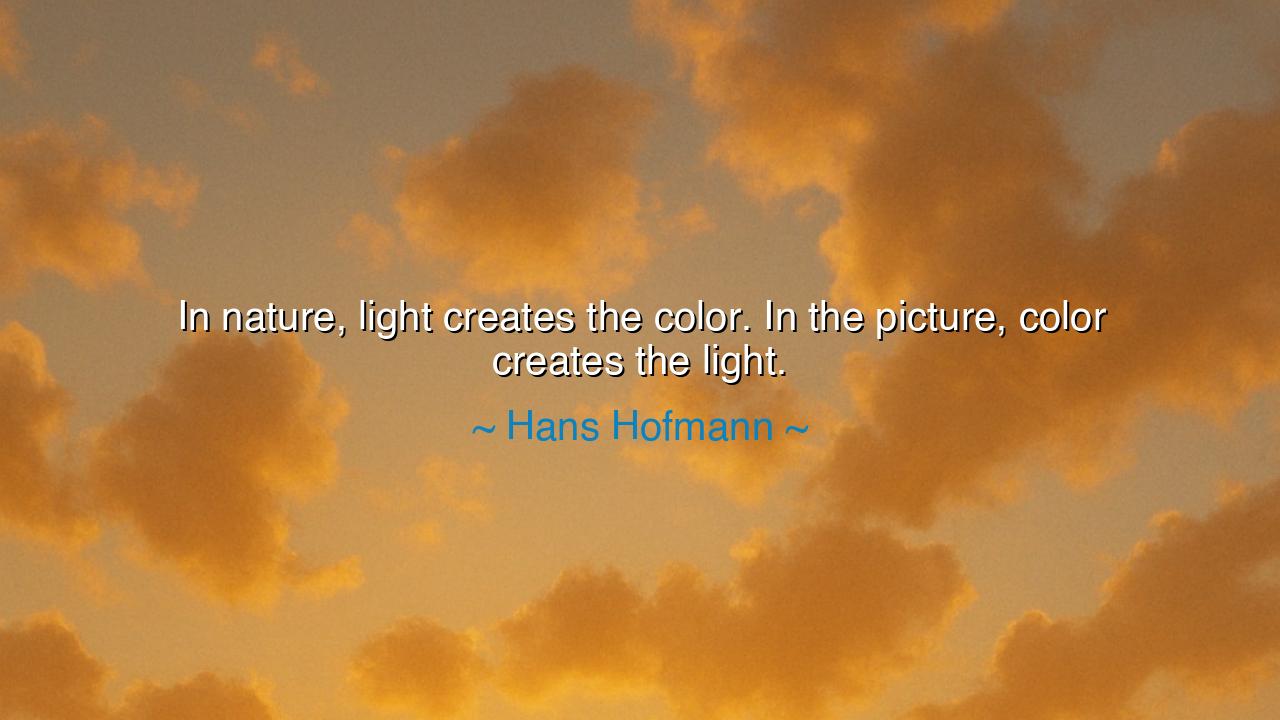
In nature, light creates the color. In the picture, color






The words of Hans Hofmann—“In nature, light creates the color. In the picture, color creates the light”—speak with the force of revelation. They remind us that the world outside and the world within are mirrors, yet each abides by its own laws. In the living realm of nature, it is the sun, the flame, the light of the heavens that awakens the hues of leaf and stone, sky and water. Without light, color is silent, unseen, asleep in darkness. But in the realm of art, the order is reversed: the painter wields color as his weapon, and through the careful shaping of red, blue, gold, and green, he conjures the very presence of light.
The origin of this insight lies in Hofmann’s life as both painter and teacher, for he stood at the crossroads of European modernism and American abstraction. He had seen the brilliance of Impressionists, who sought to capture the fleeting play of light in nature, and he had watched the rise of artists who no longer sought to imitate the external world but to create a new world upon the canvas. For him, color was no longer passive, a thing revealed—it was active, a thing revealing. Through bold contrasts, through harmony and tension, a painting could glow as though it carried its own sun within.
History shows us the truth of this in the work of the Impressionists themselves. When Claude Monet painted his haystacks, he was not depicting straw alone, but the radiance of dawn, dusk, and mist. The colors on his canvas—purple shadows, golden glows, scarlet whispers—were arranged not merely to represent the stacks, but to create the illusion of light itself, shimmering and alive. Where nature requires the sun to awaken color, the painter requires only pigment and vision to summon the miracle of radiance upon a flat surface.
The emotional depth of Hofmann’s words lies in the power they give to the human spirit. For in nature, we are receivers, humbled before the gifts of light and color. We stand in awe as morning breaks or as twilight burns the sky. But in art, we are creators, shaping with our own hands the essence of what inspires us. The painter, the poet, the musician—each takes what is received from the world and, by transformation, becomes a source of light for others. It is a reminder that within man lies not only the ability to reflect creation, but to add to it.
There is also a heroic lesson here: that we are not bound only to be imitators of nature. To live merely as mirrors is to live small. But to learn the principles of light and color, and then to reverse them, to make of color a source of light and of art a source of life—that is to rise into true creativity. The artist who does this walks as a bridge between earth and spirit, between the world that is given and the world that is made.
The lesson for us is not only for painters but for all who create. In life, too, there are things we receive—circumstances, traditions, environments. These are like the light of nature, shaping us, revealing what is already present. But there are also things we make—our choices, our words, our deeds. These are like the colors on the canvas, which create new light, new meaning, new worlds. To live fully is to honor both: to receive what is given with gratitude, and then to transform it into something radiant through our own hands.
What, then, shall we do? Let us look upon the natural world with awe, learning from its laws. But let us also remember the power within us to shape reality through creation. If you are a painter, use color boldly. If you are a writer, use words as pigments that illuminate. If you are a teacher, a leader, or a parent, let your guidance be the light that others may see. In this way, Hofmann’s teaching becomes universal: the world gives us light, but we must give back light through our works, through our colors, through our lives.
Thus, Hofmann’s words endure not as an observation of art alone, but as a call to life itself. Nature reveals light through color; art reveals light through color. And so, too, the human soul may take what is given by the universe and return it, transfigured, as a new radiance. This is the destiny of all who live not merely to exist, but to create.






AAdministratorAdministrator
Welcome, honored guests. Please leave a comment, we will respond soon